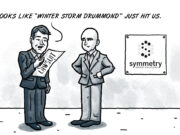

Of all the assumptions and stereotypes people have about how governments work, there’s at least one that’s universally true: Everything has to happen by the book, often in an idiosyncratic and bureaucratic fashion. A lot of the time, the book is something few people have heard of.
That’s the case for an issue that affects all of us whenever we’re out and about. Every traffic signal, sign, crosswalk, bike lane and stripe you see is designed and installed according to a thick, densely written and relatively obscure book by the federal government. There is, of course, a clunky acronym involved. It’s called the Manual on Uniform Traffic Control Devices (MUTCD).
The government is in the process of updating the MUTCD for the first time in more than a decade, and today — Friday, May 14 — is the last day to make your voice heard during a rare chance to influence how that book is written for the coming years. Speak up and let the Federal Highway Administration know the importance of prioritizing simple design and installation practices to improve bike and pedestrian safety.
Bureaucratic rules make our streets deadlier
The National Association of City Transportation Officials (NACTO) has taken the lead on identifying fundamental problems with the current regulations governing traffic design, such as laying out intersections that prioritize cars over pedestrians and allowing little flexibility for the differing needs of individual locations. You can read more about those problems here.
In short: Outdated, nonsensical bureaucratic rules make our streets deadlier for everyone by allowing cars to drive faster than even engineers think is safe. You’ll find that almost every single one of the 20 most dangerous states for pedestrians is in the southern half of the United States, where urban growth exploded according to the car-driven development styles of the 20th century. Oklahoma is on that list. One of the few exceptions on the list is Michigan, which is in the northern half of the country but was also the automotive capital of the world during that time.
We all feel it everywhere we go. There are places where we feel safer on foot, on a bike or waiting for the bus. Those streets have clear and wide crosswalks, planters between the sidewalk and the curb, and protected bike lanes. Drivers subconsciously drive more slowly in more narrow traffic lanes, making everyone in and around the vehicles safer. We don’t have enough places like that, and it will take time and money to build more.
It’s time to implement modern best practices
We have hard data in Oklahoma City showing where we have the most pressing safety needs. You can look at heat maps by location and time in bikewalkokc, the city’s master plan for cycling and pedestrians. (The heat maps are on pages 57 and 89 of the full plan.) If you pick a dangerous spot for pedestrians or cyclists on the heat map, it’s almost certainly going to be at a location where the infrastructure was designed only for cars to go fast, and not to keep people safe whether they’re in a car or not. And some of the simplest, cheapest solutions are unavailable just because the MUTCD doesn’t allow them.
To pick one infamous example, the MUTCD doesn’t allow crosswalk art. The federal government relies on a discredited study from nearly 50 years ago in saying it’s unsafe. Study after study, even one by the feds themselves, tells us what we already know instinctively: A distinctive, well-marked crosswalk gets drivers’ attention, and they slow down.
But until the federal government makes modern best practices more prominent in the MUTCD, Oklahoma City and every other community in the U.S. can’t legally make use of them. When a local government would like to try something cheap to improve safety — like changing how it paints a street — it should be able to. Not every street can be fixed overnight with an expensive rebuild that includes better sidewalks and a protected bike lane, but we can do a lot of good with more inexpensive fixes while we make progress on the rest.
That’s only one issue out of dozens that need to be addressed by the MUTCD. But, luckily, organizations such as NACTO , Transportation for America and America Walks provide easy ways to reach out and make your voice heard today. Take a few minutes to click one of those links and let the government know what the book should say, so we can do it by the book the right way.




















